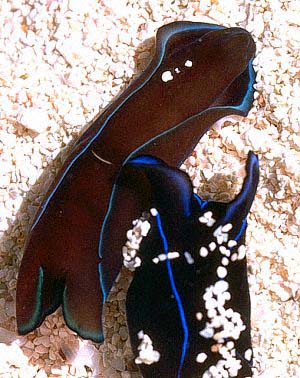
Philinopsis gardineri
(Eliot, 1903)
Order: CEPHALASPIDEA
Family: Aglajidae
DISTRIBUTION
Known previously, only from the tropical western Pacific, but records on the Forum from Reunion Island and Western Australia show it has a wide Indo-West Pacific distribution.
PHOTO
Heron Island, Great Barrier Reef, Queensland, Australia. June 1983. Up to 5cm long alive. Photo: Bill Rudman.
Philinopsis gardineri is very similar in colour to the related Chelidonura varians from which it can be easily separated by the long pointed posterior tails present in Chelidonura.
The Aglajidae are all carnivorous hunters, and species of Philinopsis are usually found burrowing in sand or sandy mud. There are two groups of species at present placed in the genus Philinopsis. The "typical" group, represented by Philinopsis cyanea , have a large partially eversible buccal bulb which is used to catch the bubble shells and other opisthobranchs which are their prey. Philinopsis gardineri represents the second "atypical" group which have a long muscular, tubular buccal bulb. We have no information on how this second group feed but it is possible that they use the buccal bulb as a long eversible tube which can catch prey (worms?) in narrow burrows or crevices. Bergh informally suggested the name "Boridium" for the group with the tubular buccal bulb, but as he wasn't sure whether his anatomy was correct or not he never formally introduced the name. Species with this foregut are usually quite easy to identify in the living animal as the folds of the tube form a rounded central crest on the head which can be seen on the photo alongside. It reminds me of the front of a jumbo jet. Other species with this type of buccal bulb include Philinopsis pilsbryi and Philinopsis lineolata.
References:
• Rudman,W.B., 1972. A comparative study of the genus Philinopsis Pease, 1860 (Aglajidae, Opisthobranchia). Pacific Science, 26: 381-399.
• Rudman,W.B., 1972. Structure and functioning of the gut in the Bullomorpha (Opisthobranchia). Journal of Natural History, 6: 547-560.
Rudman, W.B., 1998 (October 14) Philinopsis gardineri (Eliot, 1903). [In] Sea Slug Forum. Australian Museum, Sydney. Available from http://www.seaslugforum.net/find/philgard
Related messages
Re: Philinopsis gardineri from nthn Mariana Islands
May 18, 2009
From: Yuji Fujie.
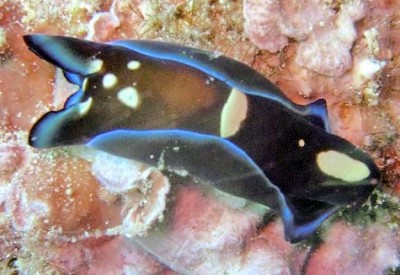
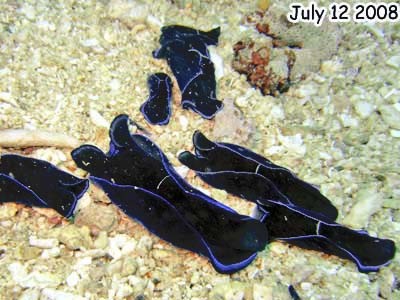
Concerning message #20077:
Dear Dr.Bill,
Here are three photos we thought were Philinopsis gardineri. This animal is very common in Saipan. However, most animals species don't have the white patches as shown in some of these photos. Usually the animal's body color is black with blue line - sometimes they hold a big party [12 July 2008 photo].I have not found their egg mass, yet.
Locality: LauLau Beach, 10 m, Saipan, Northern Mariana Islands, Pacific Ocean, 09 March 2009 [spotted animals] & 12 July 2008 ['party' animals], sandy around. Length: 20 mm. Photographer: Yuji Fujie..
Best regards,
Yuji
scuba.element@gmail.com
Yuji Fujie, 2009 (May 18) Re: Philinopsis gardineri from nthn Mariana Islands. [Message in] Sea Slug Forum. Australian Museum, Sydney. Available from http://www.seaslugforum.net/find/22412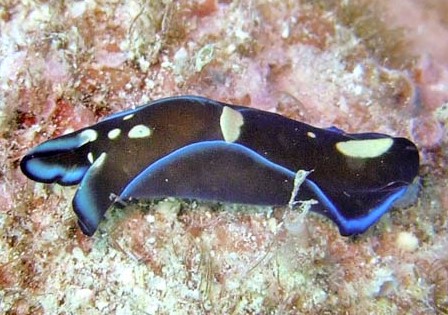
Dear Yuji,
I agree that the spotted animals are most likely to be P. gardineri, but I must say I haven't seen this colour form before. From your lower photo I can see that the spotted animal has the same bump on its head, showing it has the same foregut arrangement as in the typically coloured animals.
Best wishes,
Bill Rudman
High Rounded bump of Philinopsis gardineri
February 27, 2008
From: Hugues Flodrops

Concerning message #18703:
Dear Bill,
To illustrate the above message, I send you a picture showing the high rounded bump on the head of Philinopsis gardineri. An other caracteristic of Gardineri from Reunion Island seems to be yellow marks on the body. Until, Philibert Bidgrain found one specimen without yellow marking.
Locality: Etang-Salé, 1 metre, Reunion Island, Indian Ocean, 29 November 2007, Night. Length: 25 mm. Photographer: Hugues Flodrops.
Best regards.
Hugues
hugues.flodrops@wanadoo.fr
Flodrops, H., 2008 (Feb 27) High Rounded bump of Philinopsis gardineri. [Message in] Sea Slug Forum. Australian Museum, Sydney. Available from http://www.seaslugforum.net/find/21398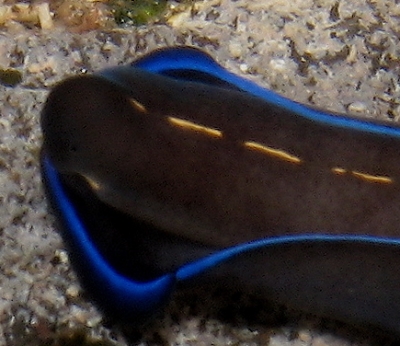
Thanks Hugues,
By co-incidence I am posting a couple of messages today about the related P. reticulata [see messages #21396, #21218]. As you will have noted on the Fact Sheet for P. gardineri, the bump on the head is caused by the long folded muscular tube which replaces the inflated buccal bulb found in most members of the genus Philinopsis. I used to describe this groups as the 'jumbo jet' species as the bump reminded me of the pilot's cabin on the Boeing 747.
Best wishes,
Bill Rudman
Mating of Philinopsis gardineri
September 14, 2007
From: Harry Blalock
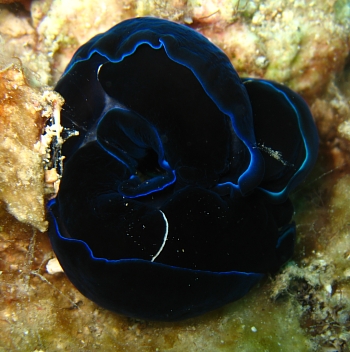
Hi Bill,
I came across 3 Philinopsis gardineri all apparently mating on a patch of soft sand the other day. I spent well over an hour just watching them to see what would happen. First one broke away and crawled about 10" away and then proceeded to bury himself in the sand. The other 2 kept going for the next 25 minutes, and then one left, wandered about 6" away and then buried himself as well. 10 minutes later the last one wandered a little bit away and also buried himself in the sand. There was a cocoon looking thing attached to the sand about 8" away from where they were all mating, and I was wondering if the cocoon is an egg sack for these guys. I'd appreciate any information you could share about the mating of these guys.
Locality: Lau Lau Bay, 25', Saipan, Northern Mariana Islands, Pacific Ocean, 9 September 2007, soft sand. Length: 3". Photographer: Harry Blalock.
Thanks,
Harry Blalock
harryblalock@gmail.com


Dear Harry,
Have a look at the messages on the similarly coloured Chelidonura varians, There are a few messages discussing mating there. My first thought would be that the mucus cocoon is an aglajid egg mass but I can see no sign of an egg string inside so the second possibility is an egg sac, perhaps empty, of a polychaete worm, such as Arenicola.
Best wishes,
Bill Rudman
Philinopsis gardineri from Ningaloo Reef
July 16, 2007
From: Kristin Anderson
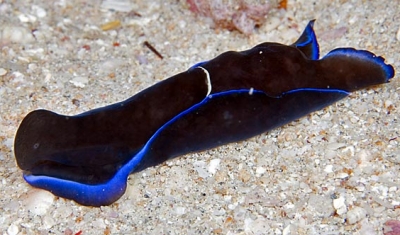
Dear Bill,
This is the first time we have seen this one here. Is it Philinopsis gardineri?
Locality: Ningaloo Reef, 12m, Western Australia, Indian Ocean, 10 June 2007, sandy bottom around limestone/coral reef. Length: 4cms. Photographer: Kristin Anderson.
Kristin Anderson
kristin@oceansbyanderson.com
Anderson, K.J., 2007 (Jul 16) Philinopsis gardineri from Ningaloo Reef. [Message in] Sea Slug Forum. Australian Museum, Sydney. Available from http://www.seaslugforum.net/find/20077Dear Kristin,
Yes this is P. gardineri.
Best wishes,
Bill Rudman
Philinopsis gardineri from Reunion Island
December 1, 2006
From: Philibert Bidgrain
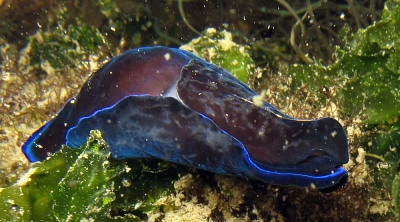
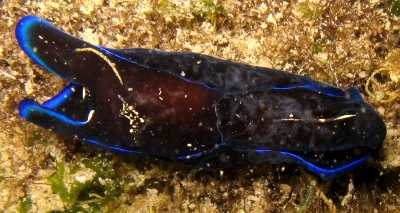
Concerning message #15398:
Dear Bill,
We found three specimens of this species in Kelonia Center (a Marine Turtle Center).These specimens have a rounded anterior body margin and a protruding bubble shaped head, not truncated like in P. cyanea.
What's your opinion about these specimens?
Locality: Saint Leu, Reunion Island, Indian Ocean, 27 November 2006. Length: 20 to 45 mm. Photographer: Philibert Bidgrain and fFrançois Beudard.
Last year, I send you a photo of P cyanea egg mass, with a characteristic sausage-shaped structure [#15333]. Have you got any information about P gardineri egg mass?
Philibert Bidgrain
http://vieoceane.free.fr/runseaslug/indexslug.htm
pbidgrain@yahoo.fr
Bidgrain, P., 2006 (Dec 1) Philinopsis gardineri from Reunion Island. [Message in] Sea Slug Forum. Australian Museum, Sydney. Available from http://www.seaslugforum.net/find/18703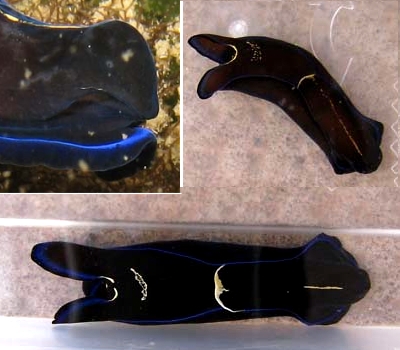
Dear Philibert,
As I said last year [message #15435], the high rounded bump on the head is a sure sign this is Philinopsis gardineri rather than P. cyanea. It is interesting to see animals with the yellow marks on the body. I can't recall seeing specimens of this species with such marks before, usually it is a uniform dark blue-black.
I would certainly be interested in photos of the egg mass of this species. We don't have any information on it.
Best wishes,
Bill Rudman
Philinopsis gardineri from Bali
December 6, 2005
From: Erwin Kodiat
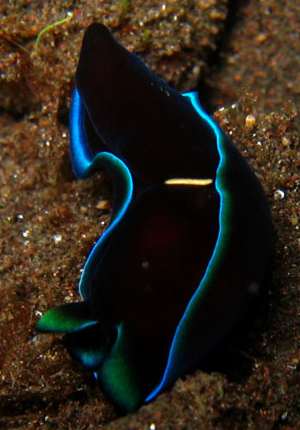
Hi Bill,
I took this shot in Tulamben, Bali, Indonesia. Just in front of Mimpi Resort, you will find many juvenile nudibranch there. However, I can't ID this. Can you help me?
Locality: Tulamben, Bali, Indonesia. Lombok Strait. Depth: 7 metres. Length: 4 cm.23 November 2005. Sandy combined with rocky bottom. Photographer: Erwin Kodiat
Thanks
Erwin Kodiat
ungu@terong.com
Erwin Kodiat, 2005 (Dec 6) Philinopsis gardineri from Bali. [Message in] Sea Slug Forum. Australian Museum, Sydney. Available from http://www.seaslugforum.net/find/15398Dear Erwin,
This is a nice message to accompany your other one which shows Chelidonura varians [message #15401]. This is the other one of the pair -Philinopsis gardineri. This photo shows the most obvious difference between Philinopsis and Chelidonura which is the blunt posterior end of Philinopsis with a small central notch, while Chelidonura has long tapering 'tails'.
Best wishes,
Bill Rudman
Philinopsis gardineri from Philippines
January 17, 1999
From: Erwin Koehler

Here is Philinopsis gardineri (Eliot, 1903), "Sara's Place", Negros Is., Philippines, Nov. 1998
Erwin.
E.Koehler@deutschepost.de
Koehler, E., 1999 (Jan 17) Philinopsis gardineri from Philippines. [Message in] Sea Slug Forum. Australian Museum, Sydney. Available from http://www.seaslugforum.net/find/480